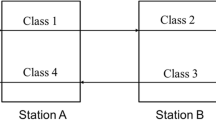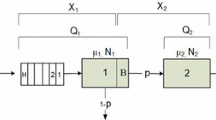Abstract
Queueing networks are studied with finite capacities for clusters of stations, rather than for individual stations. First, an instructive tandem cluster example is studied to show that a product-form modification method for networks with finite stations can be extended to networks with finite clusters. Next, general results are established by which finite clusters can be regarded as finite aggregate stations. By these results product-form modifications for finite stations can be extended to product-form modifications for finite clusters by just considering a network at cluster level. This may lead to simple performance bounds. A number of illustrative examples with numerical support are provided.
Similar content being viewed by others
References
T. Altiok and H.G. Perros, Queueing Networks with Blocking (North-Holland, Amsterdam, 1989).
S. Balsamo, Approximate analysis of queueing networks with blocking, in: Proc. Tutorials TOOLS'98, Palma de Mallorca, Spain (14-18 September 1998).
S. Balsamo, V. De Nitto Personè and R. Onvural, Analysis of Queueing Networks with Blocking (Kluwer Academic, Dordrecht, 2001).
S. Balsamo, L. Donatiello and N.M. van Dijk, Bounded performance analysis of parallel processing systems, IEEE Transactions on Parallel and Distributed Systems (1998) 1041-1056.
S. Balsamo and G. Iazeolla, Aggregation and disaggregation in queueing networks: The principle of product-form synthesis, in: Mathematical Computer Performance and Reliability, eds. G. Iazeolla, P.J. Courtois and A. Hordijk (North-Holland, Amsterdam, 1984) pp. 95-109.
S. Balsamo and B. Pandolfi, Bounded aggregation in Markovian networks, in: Mathematical Computer Performance and Reliability, eds. G. Iazeolla, P.J. Courtois and A. Hordijk (North-Holland, Amsterdam, 1988) pp. 73-92.
S. Balsamo and A. Rainero, Approximate performance analysis of queueing networks with blocking: a comparison, Research Report RR/05/98, Department of Mathematics and Computer Science, University of Udine (1998).
R.J. Boucherie, Norton's equivalent for queueing networks comprised of quasi-reversible components linked by state-dependent routing, Performance Evaluation 32 (1998) 83-99.
R.J. Boucherie and N.M. van Dijk, A generalization of Norton's theorem, Queueing Systems. Theory and Applications 13 (1993) 251-287.
Y. Dallery and Y. Frein, A decomposition method for the approximate analysis of closed queueing networks with blocking, in: Queueing Networks with Blocking, eds. H.G. Perros and T. Altiok (North-Holland, Amsterdam, 1989) pp. 33-46.
Y. Dallery and D. Kouvatsos (eds.), Queueing Networks with Blocking, Annals of Operations Research 79 (1998), special issue.
S. Kumar, R. Srikant and P.R. Kumar, Bounding blocking probabilities and throughput in queueing networks with buffer capacity constraints, Queueing Systems. Theory and Applications 28 (1998) 55-77.
M.Miyazawa and H. Tijms, Comparison of two approximations for the loss probability in finite buffer queues, Probability in the Engineering and Informational Science 7 (1993) 19-27.
H. Perros, Queuing Networks with Blocking (Oxford University Press, 1994).
Proc. of the Fourth International Workshop on Queueing Networks with Finite Capacity (July 2000) pp. 20-121.
P.J. Schweitzer and T. Altiok, Aggregate modelling of tandem queueus with blocking, in: Computer Performance and Reliability, eds. G. Iazeolla, P.J. Courtois and O. Boxma (North-Holland, Amsterdam, 1988) pp. 135-149.
Y. Takahashi, Aggregate approximation for acyclic queueing networks with communication blocking, in: Queueing Networks with Blocking, eds. H.G. Perros and T. Altiok (North-Holland, Amsterdam, 1989) pp. 33-46.
N.M. Van Dijk, A formal proof for the insensitivity of simple bounds for multi-server non-exponential tandem queues based on monotonicity results, Stochastic Processes and Applications 27 (1988) 261-277.
N.M. Van Dijk, Simple bounds for queueing systems with breakdowns, Performance Evaluation 8 (1988) 117-128.
N.M. Van Dijk, Product Forms for Queueing Networks: A System's Approach (Wiley, New York, 1993).
N.M. Van Dijk, Bounds and error bounds for queueing networks, Annals of Operations Research 79 (1998) 295-319.
N.M. Van Dijk and W.K.Grassmann, The product formtool for queueing networks, in: Computational Probability, ed. W.K. Grassmann (Kluwer Academic, Amsterdam, 1999) pp. 409-444.
N.M. Van Dijk and M. Miyazawa, A note on bounds and error bounds for nonexponential batch arrival systems, Probability in the Engineering and Informational Sciences 11 (1997) 189-201.
N.M. Van Dijk and P.G. Taylor, Strong stochastic bounds for the stationary distribution of a class of multicomponent performability models, Operations Research 46 (1998) 665-674.
N.M. Van Dijk and J. Van der Wal, Simple bounds and monotonicity results for multi-server exponential tandem queues, Queueing Systems. Theory and Applications 4 (1989) 1-16.
Author information
Authors and Affiliations
Rights and permissions
About this article
Cite this article
van Dijk, N.M., van der Sluis, E. Simple Product-Form Bounds for Queueing Networks with Finite Clusters. Annals of Operations Research 113, 175–195 (2002). https://doi.org/10.1023/A:1020922315539
Issue Date:
DOI: https://doi.org/10.1023/A:1020922315539




